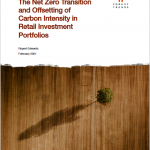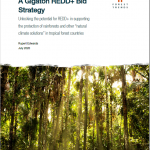Forest Trends’ Public-Private Finance Initiative works with public and private sector partners to create innovative mechanisms that increase financial flows to forest conservation and low-deforestation agriculture in tropical forest countries.
Tropical forests store carbon, protect watersheds, and provide havens for biodiversity, but they are under pressure from competing land uses, such as agriculture. It is possible to transform agriculture to more sustainable models, but the costs cannot all be met by the public sector. The Public-Private Finance Initiative works to address this issue in three ways:
Our approach
1) Innovative Finance
A massive increase in public and private results-based funding commitments is critical to protect tropical rainforests and other natural climate solutions in tropical forest countries, and thus to hopes of holding global warming below 2°C. We’re calling for donor governments and multilateral institutions to seize the growing opportunity to leverage private co-funding for a “Green Gigaton Bid” that would deliver one billion tons of emissions reductions from forests, and catalyze even larger-scale private and public funding commitments. At a macroeconomic level, the success of natural climate solutions and of REDD+ is critical to preventing carbon prices from escalating rapidly, thus reducing political ambition when emission reduction policies need to be tightened.
We also see great potential to use public sector money to reduce risks for the private sector in investing in forest conservation and farming models that conserve and restore forests and degraded lands. For example, in Brazil, we are working with the World Bank to design “forest bonds.” These are bonds, issued to the mainstream debt markets, where the proceeds are allocated towards forest protection in the Brazilian Amazon. This might mean providing low-cost loans to farmers to help them preserve a certain percentage of their land as forest and, in doing so, help them comply with the Brazilian Forest Code.
2) Integrated Finance
We see a great opportunity to link forest conservation to sustainable commodity markets and supply chains via mechanisms such as certification and income from sale of REDD+ credits. For example, in Peru and Brazil, we are working with local entrepreneurs, project developers, and international asset managers to explore ways of including small farmers in coffee and cocoa supply chains. Methods to do so include linkages with European specialty commodity markets, guarantees from development finance institutions, and income from project and jurisdictional REDD+ credits.
3) Efficient Finance
It is often cheaper for small farmers to expand into nearby forest rather than increase the productivity of the land they already own. In addition, smallholders often find it difficult to access low-cost loans for their work from state banks. We are helping farmers to more easily access international climate finance that would allow them to improve the productivity of their farming operations. For example, we’ve worked in the State of Mato Grosso, Brazil with the Forests, Farms, and Finance Initiative to develop a zero-deforestation certification scheme and accompanying high-level finance mechanisms that will reward farmers for conserving forests and increasing yields on existing land.
The financial sector is witnessing a rapid evolution in climate metrics, driven by both regulatory pressure and consumer-driven trends toward sustainable investment, helping investors prioritize lower carbon investments. We’re exploring the potential for financial product offerings that mobilize demand for climate mitigation and carbon offsets from retail and mainstream investors.
Key Results
- We launched the “Green Gigaton Challenge,” a new partnership with the UN Environment Program, Emergent Climate, the Architecture for Trees (ART), and the Environmental Defense Fund. The Challenge aims to mobilize funds for at least one gigaton of high-quality forest-based emission reductions per year by 2025: the equivalent of 257 coal-fired power plants taken offline for a year, or growing 16.5 billion new trees.
- With the World Bank and Vivid Economics, we’ve designed a green Forest Bond for Brazil that harnesses innovative enhanced bond structures to catalyze significant increases in funding flows for climate mitigation.
- Our Land Carbon Policy Roadmap, created together with the Nicholas Institute at Duke University, lays out how the land sector can play an important role in delivering on the U.S. Paris commitment, providing an “insurance policy” for other sectors as we reduce emissions across the economy.
- We’ve proposed a new Global Climate Finance Foundation to harness retail investor “willingness to pay” for climate mitigation – an idea that public equities research group Redburn Review has called “required reading for CIOs.”




